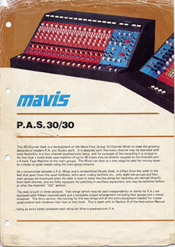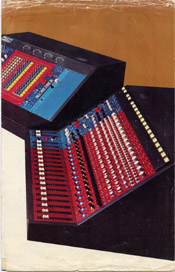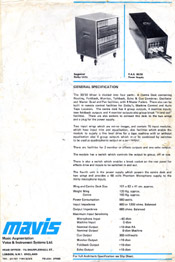The Who’s PA: Quadrophonic PA and MAVIS desk
About this page
Former Who Quadrophonic Mavis desk photos and information courtesy Kurt Schrotenboer.
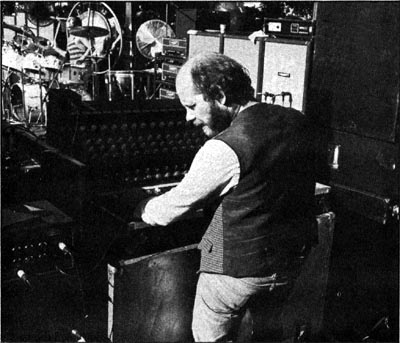
Ca. 1976, Bob Pridden running the Mavis desk at stage left.
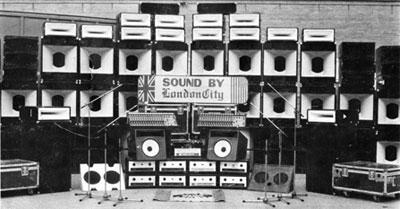
Click to view larger version. London City Ent. LTD photo of PA. Courtesy Kurt Schrotenboer
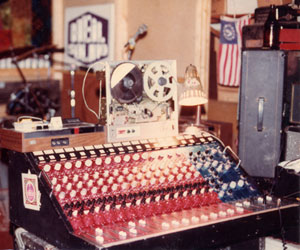
Click to view larger version. Mavis desk. Courtesy Kurt Schrotenboer
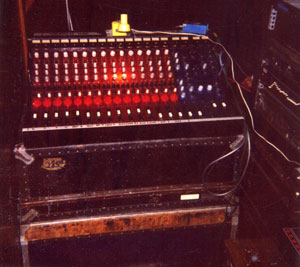
Click to view larger version. Mavis desk. Courtesy Kurt Schrotenboer
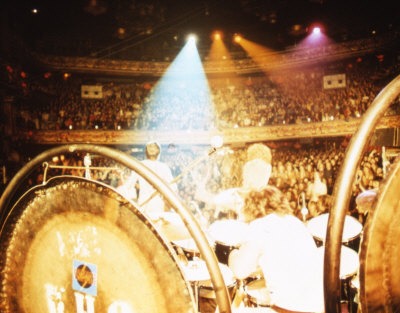
Ca. 1973, view of rear (“Quadrophonic”) PA speaker stacks at back of hall.
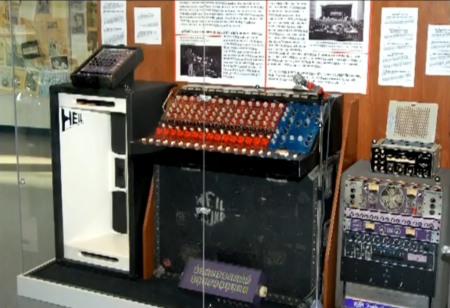
Mavis (“Quadrophonic”) desk, and Heil rear surround PA speaker from back-of-hall setup (plus a Shure microphone), on display at the Rock and Roll Hall of Fame installation for Bob Heil.
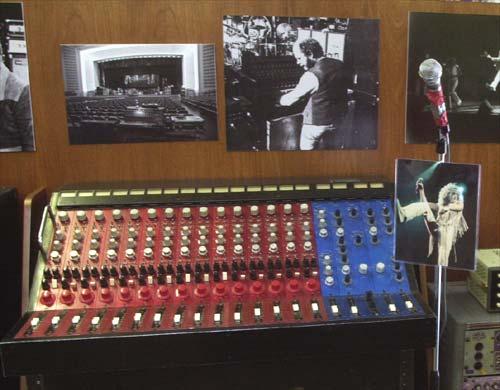
Quadrophonic Mavis sound system mixer (plus a Shure microphone) on display at the Rock and Roll Hall of Fame installation for Bob Heil.
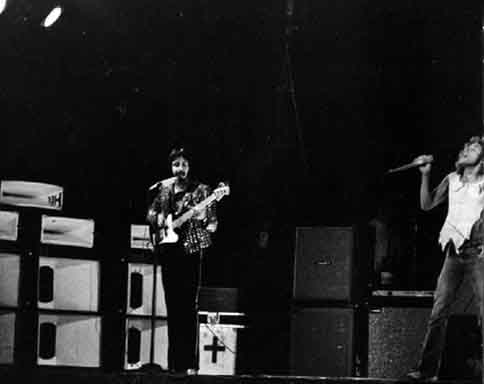
14 June, 1974, at Madison Square Garden, John in front of Heil PA sidefill monitor stacks with white-painted horn bells. Photo courtesy Dave Kleinwaks.
I own a M.A.V.I.S audio desk. I have used the desk for my recordings and used it for many bands I was in. It still all works. I was an employee of a sound company that purchased a P.A.S. from Bob Heil. Bob can verify that this is one of the two desks he sold to London City Ent. LTD. (See pictures of the system and the audio desks and the factory brochure for the last MAVIS quad consoles that were used for the first California Jam.) There are no origination documents; however, I was informed that they were made in England. These desks were built with the finest craftsmanship with engraved lettering, anodized aluminum pullout channels and master tracks, Penny Giles faders, built in tri-amp crossovers and weighs 285 lbs in the flight case with power supply.
We didn’t put all of the speakers in the main system picture since some drivers were being reconed at the JBL factory and some 4560s were being outfitted with new model 2225s for more power-handling ability. There were over 24 4560s. On the bottom of the system picture were four Olsen tri-folds with JBL 2205s. We called them “refrigerator cabs.” They had huge casters on the back side and so they were nice to pile a bunch of equipment on top and roll them in the the non-union auditoriums. We did repaint the 4560s, which were very beat up and wanted them to go along with the Heil scheme of white horn bells. On the top were JBL bullits, eight to a box. You can see the top hat JBL long throws on the sides of the picture. The two wedge monitors sit in front and the middle shows two drum monitors with Heil white cone speakers. The side fills are there too with two 2205s and horn for each. Even though Heil had introduced his designed horn bells, they were loaded with JBL drivers. The entire system was loaded with JBL speakers except for the two drum monitors. In addition to the Crown DC-300s in front there were two Phase Linear 700s, which powered the Tri-folds and a Crown DC-150 for the bullits. The speaker cables all had twist-lock 220-volt plugs … a bit beefy for speaker power but they never failed. The two main snakes were 250 foot and 225 foot. The shorter one was used for stage front and longer one for drums stage back. There also was two 50-foot mic-splitter snakes, which went to the side foldback (monitor) Heil (semi-Mavis duplicate) desks.
The M.A.V.I.S. (musical augmentation voicing instrumentation system) desks are 15 channel with input attenuator, four-band EQ, pan, cue, pre post EQ-switched echo send, two monitor sends and four track-assignment switches. They are encased in their own metal enclosure with a buss connector. The faders were made by Penny Giles in England. The face panels are anodized aluminum with white back-filled script lettering. The blue section is four tracks with track 1 and 2 assignable to a built in tri-amp crossover, which sends the six signals tr1-hi 1-mid 1-lo tr2-hi 2-mid 2-lo through the mains snake and are split off with two fans snakes to stage left and right and connected to the amplifier inputs. Track 3 and 4 can be sub-mixed into track 1 and 2 or outputted to a recorder and both have four-band EQ. The two monitor and one echo sends also have four-band EQ. You can also monitor any one of the outputs using two rotary switches, which assigned the signals to tr 3 and tr 4 V.U. meters. You can see that there are 19 back-lighted V.U. meters on the top of the desks. The output driver circuits use 300 mw current amplifiers, which drive the balanced lo-z transformers to push the signal down the long length of cable without signal degradation. Each snake had an additional five lines, which were accessed from an aux connector on the back of the desks so you could use 10 more lo-z lines for spares and stage intercom. Each mains snake has one huge connector that connects to its mate on the back of the desk. These desks weighed 285 lbs with the power supplies in the flight cases. Ouch … my back! I can hardly believe they used to fly these things around at that weight but there were JFK airport stickers on the cases. heheh
The entire system usually took five to six hours to set up and four hours to pack up. We used a 45-foot semi-trailer for transport, which was larger than normal because we also carried the records and T-shirts, etc., for the groups that contracted with us. A 35-foot GMC mobile home complimented the rig, which was our home and kitchen and bathroom. Let me say this … it is not a good job and was very dirty and we all were robbed of sleep since two people had to drive and co-drive each rig, which meant that only six dudes could sleep at any given time on the road. Usually we left immediately after the packup and were off to the next show. No fun … no screwing around … no parties… no groupies … no whores … no glory whatsoever! The company should have been called “Rock and Roll Nanny Service” since most of the contracted groups were very fussy and a bit insane. Many times at various venues there were union crews, which had to do most of the transporting of equipment to and from the venue entrance to the stage area and many of them recognized the system as being the “Old Who Quadrophenia system.” We hated most of them morons. Some were even drunk when working and dropped records and other things. So much for union workers … bunch of bums.
Acquiring the system
The system was purchased from Bob Heil the summer of 1976. The company went bankrupt in 1978 and I bought main Mavis desk and snake system from the liquidator. My friend and bass player in the band we formed bought the other Mavis desk and snake system, which was used for the drum mix. The pair of them got a lot of attention in all the venues we performed in.
I was told that ShowCo also had a few of these desks. There were 28 made like as in the pictures.
There were two more made with a middle switching console. They were just like the first model except for having five-band EQ and a quad joy stick instead of pan for each of the 15 channels and also had a middle quad switching desk. They were made mirrored brother and sister with the blue track sections on the traditional left and the other desk tracks on the right side. This final system was purchased by Emerson Lake and Palmer and they insisted that the system be used for the California jam, which had quad speaker towers. I only have the brochure of that system with the system picture in the middle of a two page-sized document.
The Mavis desks were designed to be almost indestructible and completely roadworthy. You could bounce these things down the road for hours and set them up and everything would work perfect just like the last show.
As far as I know back in the late ’60s there were no audio mixing desks before these units with the exception being Gately. Gately first made audio mixers for the military and later became Tascam. There were some small tube amplifiers with a few channels made by Bogen, which later on became Lear Seagler, but these were mostly used for sports fields and were usually connected to outdoor-designed Atlas horns. Jim Marshall also assisted The Who and made a tubed P.A.S. with speaker columns.
Final Mavis 30/30 P.A.S.
Bob Heil:
That Mavis was built for David Hartstone who had a sister company of ours … I.E.S. David had a tremendous amount of cash stuck into a monster system in England and patterned it much after the Heil System so we could fill the needs of our clients USA or Europe. That Mavis was built for the ELP tours. Unfortunately it was after Quadrophenia but my Quadrophenia system was the nucleus of the idea for Dave to do that. I have no idea what ever happened to that quad console.
Chris Quayle, formerly of IES:
A few comments about Mavis mixer history. I moved to London in 1974 to work for IES, (International Entertainers Services), doing mixer design work on the Mavis desks. They were an all Brit design, with quad panpots, (joy stick) on each channel, built in house using 4 bourns submin linear travel potentiometers and a resistor network. All the transistors were hand selected for noise figure and modules were distortion checked using a Radford DMS2 measuring set.
The main business was PA hire and the Mavis desks + JBL + Crown DC300’s were used to support this. We even did our own speaker remagnetisation and reconing. For large shows, there would usually be a Mavis up front, then a second on for monitors at stage side. I forget the exact config, but it would usually be w bins, bins, lenses and bullet top end, all JBL.
I know that Dave Hartstone sold a couple of desks to Bob Heil at some point, but forget how many and that’s perhaps where my recollections and your page info varies. The engineer at IES was a very talented guy named Bill Hough, who was responsible for all the Mavis mixer designs. The electronic crossovers and other stuff like the stage boxes and Belden multicores.
Mavis, I believe, was the name of Dave Hartstones’s mother!
Resources and Information
Acknowledgements
- Thanks to Kurt Schrotenboer.
- Bob Heil
- Chris Quayle
- Mark Mander
